Adrian Weller
University of Cambridge, The Alan Turing Institute
Wavelet-Induced Rotary Encodings: RoPE Meets Graphs
Sep 26, 2025Abstract:We introduce WIRE: Wavelet-Induced Rotary Encodings. WIRE extends Rotary Position Encodings (RoPE), a popular algorithm in LLMs and ViTs, to graph-structured data. We demonstrate that WIRE is more general than RoPE, recovering the latter in the special case of grid graphs. WIRE also enjoys a host of desirable theoretical properties, including equivariance under node ordering permutation, compatibility with linear attention, and (under select assumptions) asymptotic dependence on graph resistive distance. We test WIRE on a range of synthetic and real-world tasks, including identifying monochromatic subgraphs, semantic segmentation of point clouds, and more standard graph benchmarks. We find it to be effective in settings where the underlying graph structure is important.
Graph Random Features for Scalable Gaussian Processes
Sep 03, 2025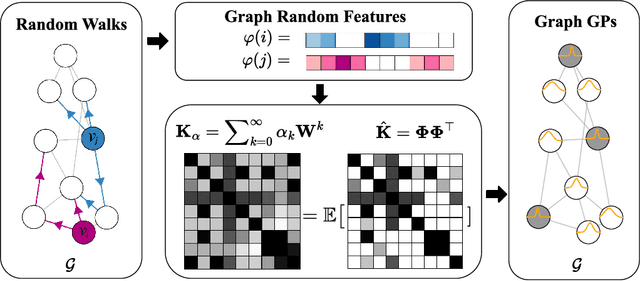



Abstract:We study the application of graph random features (GRFs) - a recently introduced stochastic estimator of graph node kernels - to scalable Gaussian processes on discrete input spaces. We prove that (under mild assumptions) Bayesian inference with GRFs enjoys $O(N^{3/2})$ time complexity with respect to the number of nodes $N$, compared to $O(N^3)$ for exact kernels. Substantial wall-clock speedups and memory savings unlock Bayesian optimisation on graphs with over $10^6$ nodes on a single computer chip, whilst preserving competitive performance.
Unequal Uncertainty: Rethinking Algorithmic Interventions for Mitigating Discrimination from AI
Aug 11, 2025Abstract:Uncertainty in artificial intelligence (AI) predictions poses urgent legal and ethical challenges for AI-assisted decision-making. We examine two algorithmic interventions that act as guardrails for human-AI collaboration: selective abstention, which withholds high-uncertainty predictions from human decision-makers, and selective friction, which delivers those predictions together with salient warnings or disclosures that slow the decision process. Research has shown that selective abstention based on uncertainty can inadvertently exacerbate disparities and disadvantage under-represented groups that disproportionately receive uncertain predictions. In this paper, we provide the first integrated socio-technical and legal analysis of uncertainty-based algorithmic interventions. Through two case studies, AI-assisted consumer credit decisions and AI-assisted content moderation, we demonstrate how the seemingly neutral use of uncertainty thresholds can trigger discriminatory impacts. We argue that, although both interventions pose risks of unlawful discrimination under UK law, selective frictions offer a promising pathway toward fairer and more accountable AI-assisted decision-making by preserving transparency and encouraging more cautious human judgment.
Orthogonal Finetuning Made Scalable
Jun 24, 2025Abstract:Orthogonal finetuning (OFT) offers highly parameter-efficient adaptation while preventing catastrophic forgetting, but its high runtime and memory demands limit practical deployment. We identify the core computational bottleneck in OFT as its weight-centric implementation, which relies on costly matrix-matrix multiplications with cubic complexity. To overcome this, we propose OFTv2, an input-centric reformulation that instead uses matrix-vector multiplications (i.e., matrix-free computation), reducing the computational cost to quadratic. We further introduce the Cayley-Neumann parameterization, an efficient orthogonal parameterization that approximates the matrix inversion in Cayley transform via a truncated Neumann series. These modifications allow OFTv2 to achieve up to 10x faster training and 3x lower GPU memory usage without compromising performance. In addition, we extend OFTv2 to support finetuning quantized foundation models and show that it outperforms the popular QLoRA in training stability, efficiency, and memory usage.
Confidential Guardian: Cryptographically Prohibiting the Abuse of Model Abstention
May 29, 2025Abstract:Cautious predictions -- where a machine learning model abstains when uncertain -- are crucial for limiting harmful errors in safety-critical applications. In this work, we identify a novel threat: a dishonest institution can exploit these mechanisms to discriminate or unjustly deny services under the guise of uncertainty. We demonstrate the practicality of this threat by introducing an uncertainty-inducing attack called Mirage, which deliberately reduces confidence in targeted input regions, thereby covertly disadvantaging specific individuals. At the same time, Mirage maintains high predictive performance across all data points. To counter this threat, we propose Confidential Guardian, a framework that analyzes calibration metrics on a reference dataset to detect artificially suppressed confidence. Additionally, it employs zero-knowledge proofs of verified inference to ensure that reported confidence scores genuinely originate from the deployed model. This prevents the provider from fabricating arbitrary model confidence values while protecting the model's proprietary details. Our results confirm that Confidential Guardian effectively prevents the misuse of cautious predictions, providing verifiable assurances that abstention reflects genuine model uncertainty rather than malicious intent.
From Dormant to Deleted: Tamper-Resistant Unlearning Through Weight-Space Regularization
May 28, 2025Abstract:Recent unlearning methods for LLMs are vulnerable to relearning attacks: knowledge believed-to-be-unlearned re-emerges by fine-tuning on a small set of (even seemingly-unrelated) examples. We study this phenomenon in a controlled setting for example-level unlearning in vision classifiers. We make the surprising discovery that forget-set accuracy can recover from around 50% post-unlearning to nearly 100% with fine-tuning on just the retain set -- i.e., zero examples of the forget set. We observe this effect across a wide variety of unlearning methods, whereas for a model retrained from scratch excluding the forget set (gold standard), the accuracy remains at 50%. We observe that resistance to relearning attacks can be predicted by weight-space properties, specifically, $L_2$-distance and linear mode connectivity between the original and the unlearned model. Leveraging this insight, we propose a new class of methods that achieve state-of-the-art resistance to relearning attacks.
Identifying, Evaluating, and Mitigating Risks of AI Thought Partnerships
May 22, 2025Abstract:Artificial Intelligence (AI) systems have historically been used as tools that execute narrowly defined tasks. Yet recent advances in AI have unlocked possibilities for a new class of models that genuinely collaborate with humans in complex reasoning, from conceptualizing problems to brainstorming solutions. Such AI thought partners enable novel forms of collaboration and extended cognition, yet they also pose major risks-including and beyond risks of typical AI tools and agents. In this commentary, we systematically identify risks of AI thought partners through a novel framework that identifies risks at multiple levels of analysis, including Real-time, Individual, and Societal risks arising from collaborative cognition (RISc). We leverage this framework to propose concrete metrics for risk evaluation, and finally suggest specific mitigation strategies for developers and policymakers. As AI thought partners continue to proliferate, these strategies can help prevent major harms and ensure that humans actively benefit from productive thought partnerships.
PoE-World: Compositional World Modeling with Products of Programmatic Experts
May 16, 2025Abstract:Learning how the world works is central to building AI agents that can adapt to complex environments. Traditional world models based on deep learning demand vast amounts of training data, and do not flexibly update their knowledge from sparse observations. Recent advances in program synthesis using Large Language Models (LLMs) give an alternate approach which learns world models represented as source code, supporting strong generalization from little data. To date, application of program-structured world models remains limited to natural language and grid-world domains. We introduce a novel program synthesis method for effectively modeling complex, non-gridworld domains by representing a world model as an exponentially-weighted product of programmatic experts (PoE-World) synthesized by LLMs. We show that this approach can learn complex, stochastic world models from just a few observations. We evaluate the learned world models by embedding them in a model-based planning agent, demonstrating efficient performance and generalization to unseen levels on Atari's Pong and Montezuma's Revenge. We release our code and display the learned world models and videos of the agent's gameplay at https://topwasu.github.io/poe-world.
When Should We Orchestrate Multiple Agents?
Mar 17, 2025Abstract:Strategies for orchestrating the interactions between multiple agents, both human and artificial, can wildly overestimate performance and underestimate the cost of orchestration. We design a framework to orchestrate agents under realistic conditions, such as inference costs or availability constraints. We show theoretically that orchestration is only effective if there are performance or cost differentials between agents. We then empirically demonstrate how orchestration between multiple agents can be helpful for selecting agents in a simulated environment, picking a learning strategy in the infamous Rogers' Paradox from social science, and outsourcing tasks to other agents during a question-answer task in a user study.
On Benchmarking Human-Like Intelligence in Machines
Feb 27, 2025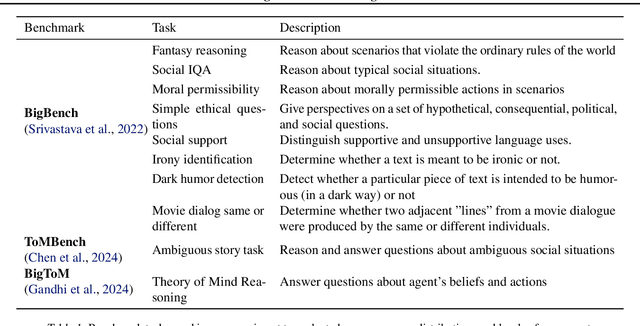
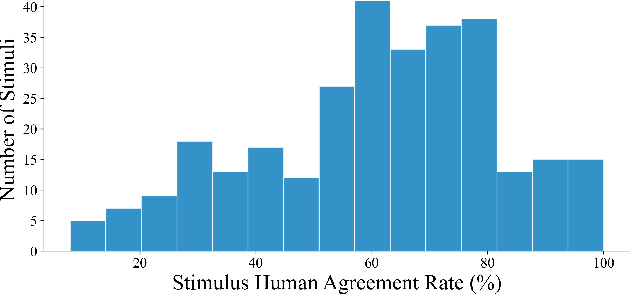
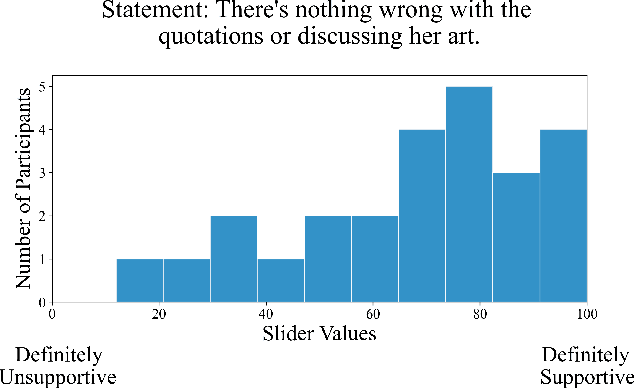
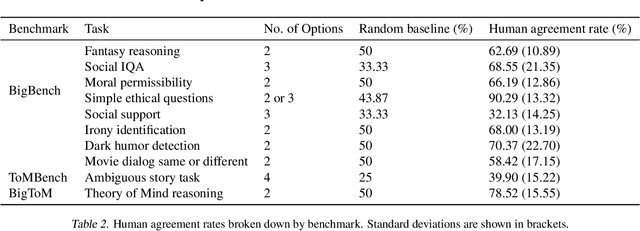
Abstract:Recent benchmark studies have claimed that AI has approached or even surpassed human-level performances on various cognitive tasks. However, this position paper argues that current AI evaluation paradigms are insufficient for assessing human-like cognitive capabilities. We identify a set of key shortcomings: a lack of human-validated labels, inadequate representation of human response variability and uncertainty, and reliance on simplified and ecologically-invalid tasks. We support our claims by conducting a human evaluation study on ten existing AI benchmarks, suggesting significant biases and flaws in task and label designs. To address these limitations, we propose five concrete recommendations for developing future benchmarks that will enable more rigorous and meaningful evaluations of human-like cognitive capacities in AI with various implications for such AI applications.
 Add to Chrome
Add to Chrome Add to Firefox
Add to Firefox Add to Edge
Add to Edge